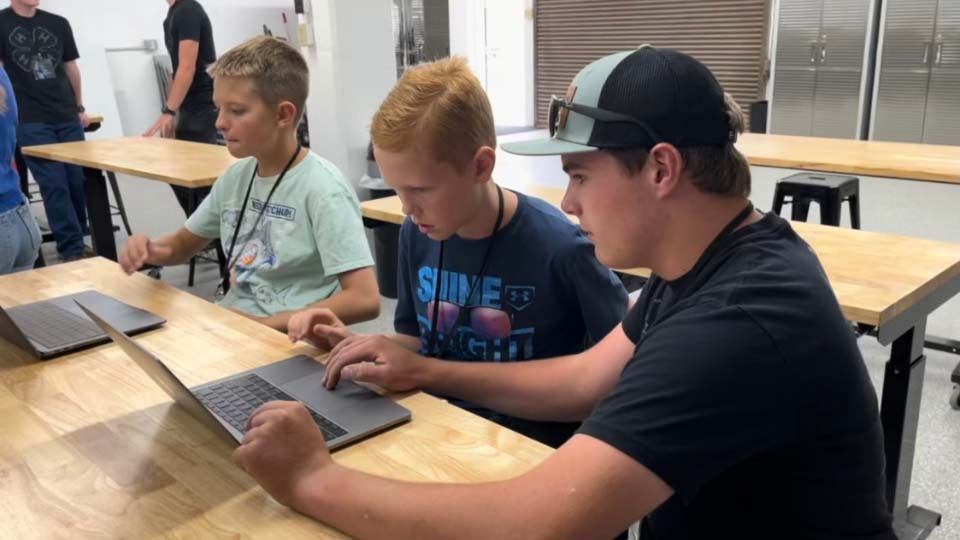STEM Sparks Rural County Youth Education

Young people in rural areas often do not have the same access to Science, Technology, Engineering, and Math (STEM) education as youth in suburban areas of the country, according to the Hechinger Report, a national educational newsroom.
While Kane County, Utah, is undoubtedly rural, with a population of around 7,000, the USU Extension 4-H youth development program has established a thriving STEM program. With only 1,300 students in grades K-12 and where all the elementary schools receive financial assistance as Title 1 schools, 80% of students in the district participate in computer science and coding education before they reach middle school. The 4-H program, in partnership with the Kane County School District, has accomplished this significant level of STEM education engagement in just six years.
Elizabeth Davis, Extension professor over 4-H in Kane County, and Angie Reidhead, 4-H program coordinator, work together for the program’s success. Their goal is to engage the future workforce early in life and provide opportunities for students to develop the necessary skills, including computer science and leadership, to prepare for the evolving work environment.
In 2016, 4-H implemented a small computer science program for students in Kanab Elementary School with funding provided by a grant from the Utah STEM Action Center. The program now has 250 students in grades 2 through 8 participating in coding education each year. This program has sparked increased interest in computer science, and 4-H has addressed this interest by expanding computer science and STEM programs to be more readily available for pre-K through grade 12 students.
In 2020, 4-H opened a Makerspace in Kane County, which provides a venue for 4-H STEM activities, teen leadership programs, and practice space for 14 First Lego League Robotics teams.
“The Makerspace has enabled us to expand and improve the teen leadership program,” said Reidhead. “Having a solid group of teen leaders who are invested in learning and growing and sharing their skills with the community has facilitated the implementation and growth of other great programs.”
One such program is an annual STEM event held in January that allows local families to experience hands-on STEM activities such as virtual reality, augmented reality, drones, circuitry, robotics, 3-D printing, and more.
“In Kanab, a town of approximately 4,500 residents, more than 815 people attended the event, which shows the investment community members have in STEM programming for their children,” Reidhead said.
Because of this, the multi-day summer STEM camps offered by 4-H always have a waiting list. The girls-only STEM camp has drawn significant attention and praise because of the innovative approach to engaging female students in technology education. Girls participating in a female-only STEM camp are more likely to engage in the learning process and pursue STEM-related careers. Participant Mia Kabella said she was eight years old when she became involved with 4-H STEM.
“I've been part of 4-H for the past six years,” she said. “My favorite part of STEM is the ability to constantly grow and learn new things.”
Kellen Cotter, a 15-year-old from Kane County, has been involved in 4-H for two years, and he’s loved the welcoming people and attitude that comes with it. He has seen the STEM program help young people learn new skills that can help them with job opportunities, and he’s also seen it help adults who learn technology from the youth they work with.
“The 3D design part of STEM demonstrates how math works,” he said. “I wish I had access to 3D modeling in middle school. It would have been so helpful to understand the math of 3-dimensional shapes.”
The Best Friends Animal Society approached Cotter and asked if he would design a prosthetic beak for a bird in their care with a broken beak. He used the skills he had developed to create a workable model and 3D print it.
“We put it on the bird, and it worked as good as new,” he said. “It was a very satisfying experience!”
In addition to STEM programs for youth, 4-H provides STEM training for teachers in the district who receive hands-on learning with augmented and virtual reality, coding projects, and Sphero coding robots to teach computer science standards. The program has also allowed
4-H youth to help instruct their teachers on using new technology in the classroom.
“It's amazing to watch these kids’ confidence grow as they use the skills they developed in 4-H to help their teachers learn new technologies,” said Reidhead.
Utah Governor Spencer Cox is committed to bringing citizens in every part of Utah access to the support necessary for prosperity. Improving rural infrastructure – roads, bridges, broadband access, and promoting telework options – is a priority to provide employers and workers with new opportunities to grow and thrive in rural areas. Cox appointed a senior advisor of rural affairs to help give rural Utahns a seat at the table.
Reidhead said improvements to the rural Utah infrastructure will allow youth more access and opportunity to live and work in their home communities while applying the skills they learned in the 4-H STEM programs.
Davis said 4-H has a legacy of bringing innovation into rural communities in Utah for over 100 years.
“These STEM programs are a continuation of what 4-H has always done,” she said. “The goal of 4-H is to make the best better and inspire the next generation of leaders, inventors, entrepreneurs, and problem solvers. We are taking that to heart with our STEM programs and have seen amazing engagement with our youth. This is particularly important in rural areas where mental health concerns are high and resources are sparse.”
Contact
Elizabeth Davis
Elizabeth.Davis@usu.edu


 Utah 4-H & Youth
Utah 4-H & Youth